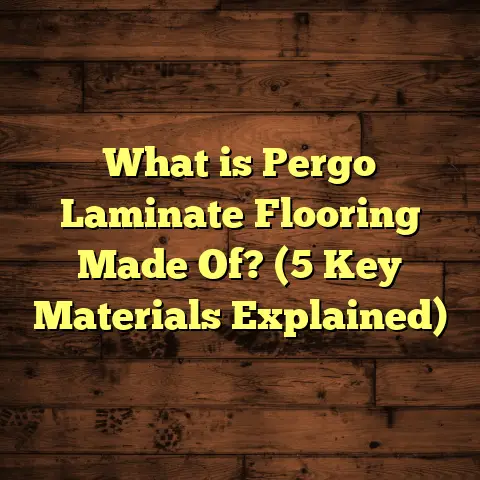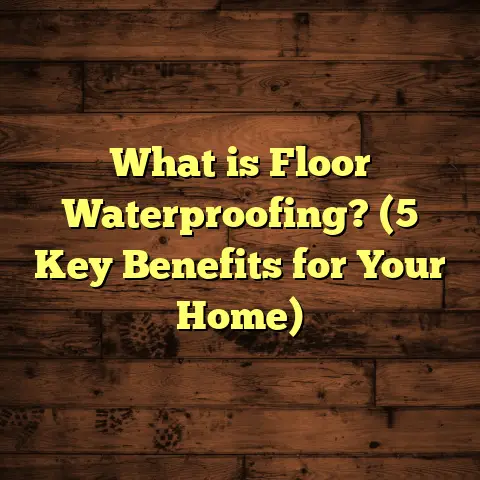What is Laminate Flooring Made Out Of? (5 Key Materials Explained)
Modern aesthetics have completely transformed how we think about home interiors. These days, it’s not just about making a space functional — it’s about making it look good, feel cozy, and reflect who you are. Flooring is one of those big elements that tie a room together. I’ve worked on countless flooring projects over the years, and I can tell you that laminate flooring has become one of my favorites to recommend and install. It strikes a balance between style, durability, and price that few other options can match.
But let me ask you—have you ever stopped to think about what laminate flooring is really made from? You might assume it’s just plastic or some cheap imitation of wood. Actually, there’s quite a bit of engineering and smart material selection behind those planks. I’m going to walk you through the five key materials that make up laminate flooring, explain what role each plays, and share some insights from my personal experience and research. By the time you’re done reading, you’ll see laminate in a whole new light.
What Is Laminate Flooring Made From?
Laminate flooring is a multi-layered synthetic flooring product designed to resemble real hardwood or stone floors without the cost or maintenance headaches typical of natural materials. It usually comes in planks or tiles and is known for its easy installation and resistance to wear.
The construction of laminate flooring is quite clever. Each layer has a specific job to do, and when combined, they produce a floor that looks great, stands up to daily life, and can fit into many budgets.
Here are the five critical materials involved:
- High-Density Fiberboard (HDF) Core
- Melamine Resin Overlay
- Decorative Paper Layer
- Backing Layer
- Balancing Layer
1. High-Density Fiberboard (HDF) Core
The cornerstone of laminate flooring is the High-Density Fiberboard (HDF) core. I like to think of this as the backbone that holds everything together.
HDF is an engineered wood product made by breaking down hardwood or softwood residuals into wood fibers, combining them with wax and resin binders, then compressing the mixture under high heat and pressure to form a solid board. The result: a dense, stable core that offers strength while still being lightweight enough for easy installation.
When I started installing floors over 15 years ago, most laminate floors were built on particleboard cores. Particleboard is less dense and more prone to swelling when exposed to moisture. HDF changed the game because it’s significantly denser and more resilient.
To give you some perspective: standard HDF typically has a density between 800 to 900 kg/m³ (kilograms per cubic meter), whereas particleboard ranges from 600 to 700 kg/m³. That extra density means better resistance to dents, impacts, and moisture damage.
Thickness-wise, laminate planks with HDF cores usually range from 7 mm up to 12 mm or more. Thicker cores improve sound insulation and give a better feel underfoot—something I always recommend if budget allows.
Personal experience: I once installed laminate in a family’s living room where two kids and their dog were running around constantly. The HDF core stood up remarkably well after years of heavy use without warping or visible damage. The family was thrilled with how durable yet beautiful their floors stayed.
2. Melamine Resin Overlay
The next layer is what protects the floor from scratches, stains, and everyday wear—the melamine resin overlay.
This transparent top layer is made by saturating paper with melamine resin combined with aluminum oxide particles. Aluminum oxide is an incredibly hard compound (it’s even used in sandpaper), which gives laminate floors their scratch resistance.
You might wonder how durable this layer really is? That’s where the Abrasion Criteria (AC) rating comes into play—a standardized way of measuring how tough a laminate floor’s surface is.
Here’s a quick breakdown of AC ratings:
- AC1: Light residential use (bedrooms or closets)
- AC2: General residential use (living rooms)
- AC3: Heavy residential use or moderate commercial use (kitchens or small offices)
- AC4: General commercial use (retail stores)
- AC5: Heavy commercial use (public buildings with very high foot traffic)
I always ask homeowners about their lifestyle before recommending a product based on AC rating. For example, if you have pets or kids or expect lots of guests regularly, AC4 or AC5 rated laminate makes sense to avoid scratches showing up quickly.
One of my clients owns a small café with wood-look laminate floors rated AC5—they’ve had customers spilling drinks and dragging chairs across the floor for over three years now with zero visible wear.
3. Decorative Paper Layer
Now we get to the fun part: the decorative paper layer that creates the floor’s visual appeal.
This layer is basically a high-resolution photographic print of wood grain, stone texture, or other surface patterns printed on special paper. Advances in printing technology have made these images incredibly realistic, capturing knots, grains, color variations—making laminate indistinguishable from real wood at first glance.
Back when I started installing laminate floors years ago, the patterns looked flat and artificial—almost cartoonish. But manufacturers have invested heavily in making this layer more authentic-looking through techniques like embossing textures into the surface to give it a tactile feel.
There are thousands of designs available now—from classic oak and walnut to exotic woods like Brazilian cherry or rustic hickory—and even stone or tile looks for places like bathrooms or kitchens.
Interesting fact: Some manufacturers use multiple layers of decorative paper combined with different finishes to create depth effects called “embossed in register,” which means the texture matches exactly where the pattern lies on the plank.
A few years ago, I installed laminate floors in an Airbnb rental that needed to impress guests without breaking the bank. We chose a rustic oak design with embossing that made it hard for visitors to believe it wasn’t real hardwood.
4. Backing Layer
The backing layer is less talked about but just as important as any other part of laminate flooring.
It sits beneath the HDF core and acts as a moisture barrier, protecting the core from dampness coming up through concrete slabs or wooden subfloors. It also stabilizes the plank by balancing out stresses from above so the floor stays flat.
If you’ve ever had floors that cup or warp over time, there’s a good chance it was due to inferior backing layers or poor moisture protection.
Backing layers are typically made from melamine-treated paper or synthetic materials designed for water resistance.
From my experience working on basement remodels or older homes with potential moisture issues, selecting laminate with an effective backing layer can make all the difference in longevity.
5. Balancing Layer
Some manufacturers add an additional balancing layer on the bottom for extra stability.
While sometimes combined with the backing layer, this material helps counteract any tension created by the upper layers during temperature or humidity changes.
It’s often made from resin-impregnated paper or another fiberboard layer engineered to maintain flatness over time.
In my installations, floors with good balancing layers have performed better during seasonal shifts when humidity fluctuates—less warping, less movement between planks.
How Laminate Flooring Materials Affect Performance
Understanding these five key materials helps explain why laminate flooring performs as well as it does—and how different choices affect durability and appearance.
For example:
- The HDF core provides strength and helps resist dents but can vary in quality based on density and thickness.
- The melamine resin overlay determines scratch resistance and stain protection; higher AC ratings mean tougher surfaces.
- The decorative paper layer impacts aesthetics—better printing and embossing equal more realistic looks.
- The backing layer protects against moisture damage from below.
- The balancing layer ensures long-term flatness and stability.
When recommending products to clients or choosing flooring for my own home, I always weigh these factors carefully based on how much traffic the area will see and what kind of environment it’s in (humidity levels, pets/kids presence).
Real-Life Case Studies & Research Insights
I want to give you some real-world examples that show how these materials play out practically:
Case Study 1: Family Room With Heavy Foot Traffic
A family I worked with wanted durable flooring for their open-concept living/dining area where kids played all day and pets roamed freely. We chose an AC4 rated laminate with a 10 mm HDF core for extra durability.
After four years, their floors still look great despite spills, toys dropped on them, and pet nails scratching around. The melamine overlay resisted most scratches while the HDF core kept everything stable without swelling from occasional mop water left behind.
Case Study 2: Basement Installation With Moisture Concerns
An older home with a damp basement needed waterproof flooring that wouldn’t warp over time. We opted for laminate featuring a thick backing layer combined with water-resistant HDF core treatment.
Even after two winters with high basement humidity levels, the floors remained flat and free from mold or swelling issues—proof that good backing layers matter.
Industry Research Highlights
- The National Wood Flooring Association (NWFA) reports average laminate lifespans between 15-25 years depending on quality.
- A Consumer Reports study showed that consumers preferred laminate floors with AC3 or higher ratings for everyday residential use.
- Data from leading manufacturers shows 70% of modern laminate uses HDF cores for improved density compared to older MDF or particleboard cores.
More About Laminate Core Materials: MDF vs Particleboard vs HDF
You might hear terms like MDF (Medium Density Fiberboard) or particleboard thrown around when talking about laminate cores—here’s how they differ:
| Core Type | Description | Density (approx.) | Moisture Resistance | Durability | Cost |
|---|---|---|---|---|---|
| Particleboard | Made from wood chips & resin glued together | 600-700 kg/m³ | Low | Least durable; prone to swelling | Lowest |
| MDF | Made from fine wood fibers & resin | 700-800 kg/m³ | Moderate | Better than particleboard but less than HDF | Moderate |
| HDF | High-density fiberboard; compressed wood fibers | 800-900 kg/m³ | High | Most durable & moisture resistant | Highest |
I always steer clients away from particleboard cores because they tend to swell and degrade faster if exposed to moisture—even small spills can cause damage over time. MDF is better but still not ideal for wet areas.
HDF cores offer the best blend of stability and toughness; yes, they cost more but pay off in longevity.
How Laminate Flooring Compares With Other Types
If you’re weighing your options between laminate and other flooring like hardwood, vinyl plank, or tile—understanding what goes into laminate helps clarify its pros and cons:
| Flooring Type | Material Composition | Durability | Cost Range (per sq ft) | Maintenance |
|---|---|---|---|---|
| Laminate | HDF core + melamine overlay + decorative paper | Good scratch & dent resistance; not waterproof unless specified | $1.50–$3 | Easy; sweep & damp mop |
| Hardwood | Solid wood planks | Can be sanded & refinished; vulnerable to scratches & moisture | $5–$10+ | Requires polishing & refinishing |
| Vinyl Plank | PVC plastic layers + wear layer | Waterproof; flexible; less natural look | $2–$5 | Very easy; waterproof |
| Tile | Ceramic or porcelain | Highly durable & waterproof | $3–$15 | Grout cleaning needed |
From my perspective installing all these types over time, laminate offers an ideal middle ground for many homeowners who want wood-look floors without splurging on hardwood or worrying about water damage like tile can bring in certain layouts.
Personal Stories From My Flooring Projects
Let me share some moments that stuck with me while working on laminate flooring installations:
One rainy day last year, I was installing laminate in a client’s kitchen that had just been remodeled. They chose a stone-look laminate with embossed texturing that fooled even me at first glance—it looked like real slate! The client told me how surprised they were at how easy it was to clean up spilled coffee without staining thanks to melamine resin overlay’s protective qualities.
Another memorable project involved a couple renovating their first home on a tight budget. They wanted something stylish yet durable enough for their two young children. We went with mid-range laminate featuring a thick HDF core and AC4 rating. A year later they called me back excited because after all those birthday parties and family gatherings their floors still looked brand new!
These stories remind me why understanding laminate flooring’s composition isn’t just academic—it genuinely influences how happy people are with their homes long term.
Maintenance Tips Based on Laminate Materials
Knowing what laminate floors are made from helps guide proper care:
- Because of the melamine resin overlay, laminate resists stains well but isn’t waterproof unless specially treated. Avoid standing water; wipe spills quickly.
- Thanks to the HDF core, do not expose floors to excessive moisture as it can swell—even if backing layers help somewhat.
- Use soft brooms or vacuums designed for hard floors to avoid scratching surfaces.
- Avoid waxes or polishes designed for hardwood—they can leave residue on melamine overlays.
- Place felt pads under furniture legs to prevent dents.
Following these tips keeps your floor looking fresh longer based on its material strengths.
Environmental Impact & Sustainability Considerations
Another point worth mentioning: how eco-friendly is laminate flooring?
Because it uses engineered wood products like HDF instead of solid hardwood planks, it makes efficient use of wood fibers including recycled content sometimes. This can reduce demand on old-growth forests compared with solid hardwood production.
However:
- The resins used in melamine overlays contain chemicals that require careful handling during manufacturing.
- Some older laminates emitted volatile organic compounds (VOCs) affecting indoor air quality but many brands now meet strict low-VOC standards.
- Proper disposal/recycling options vary regionally but are improving as manufacturers explore circular economy approaches.
If sustainability matters to you (it does to me!), look for certifications like FloorScore or GREENGUARD indicating low chemical emissions and check manufacturer transparency on sourcing practices.
Why Understanding Laminate Materials Matters When Choosing Flooring
At first glance, picking a floor might seem as simple as liking a color or pattern—but there’s much more beneath the surface than meets the eye. Knowing what makes up your laminate flooring helps:
- Match product specs with your lifestyle needs (kids? pets? moisture concerns?)
- Avoid common pitfalls like buying cheap particleboard core laminates prone to damage
- Understand warranties better by knowing what materials affect durability
- Communicate clearly with contractors about your expectations
- Get better value by investing in higher quality cores and overlays where it counts
For me personally, this knowledge helped me choose laminate for my own home’s hallway where foot traffic is heavy but budget was tight—we went with an AC4 rated product with thick HDF core that has lasted beautifully through years of shoes coming in wet from rainstorms without issues.
Summary Table: Laminate Flooring Components at a Glance
| Material | Purpose | Typical Composition | Key Benefits |
|---|---|---|---|
| High-Density Fiberboard (HDF) Core | Structural support | Wood fibers + resin + wax compressed under heat/pressure | Strength & stability; moisture resistance |
| Melamine Resin Overlay | Surface protection | Melamine resin + aluminum oxide particles | Scratch resistance; stain protection |
| Decorative Paper Layer | Visual design | High-resolution printed paper | Realistic wood/stone look |
| Backing Layer | Moisture barrier & stability | Melamine-treated paper or synthetic material | Prevents swelling; adds dimensional stability |
| Balancing Layer | Counteracts warping | Resin-impregnated paper/fiberboard | Maintains flatness during humidity changes |
FAQs About Laminate Flooring Materials
Q: Is all laminate flooring water-resistant?
A: No. Standard laminates resist spills but aren’t fully waterproof due to the HDF core swelling if exposed long-term to moisture. Special waterproof laminates use treated cores or added barriers for wet areas.
Q: Can laminate be refinished like hardwood?
A: No. Laminate cannot be sanded or refinished because its design relies on a thin decorative layer over fiberboard rather than solid wood surface.
Q: How long does laminate flooring last?
A: Lifespan varies by quality but generally ranges from 15-25 years depending on wear and maintenance.
Q: Is thicker laminate better?
A: Thicker planks often provide better sound absorption and feel more solid underfoot but quality of materials matters most overall.
I hope this thorough explanation helps you understand what goes into making laminate flooring tick! From dense fiberboard cores supporting realistic printed designs sealed under tough melamine overlays to moisture-blocking backings keeping everything stable—it’s no wonder this flooring type has become so popular among homeowners seeking beauty, durability, and affordability all in one package.
If you want advice on choosing the right product for your home or tips on installation and care based on these materials, just ask—I’m here to help!





